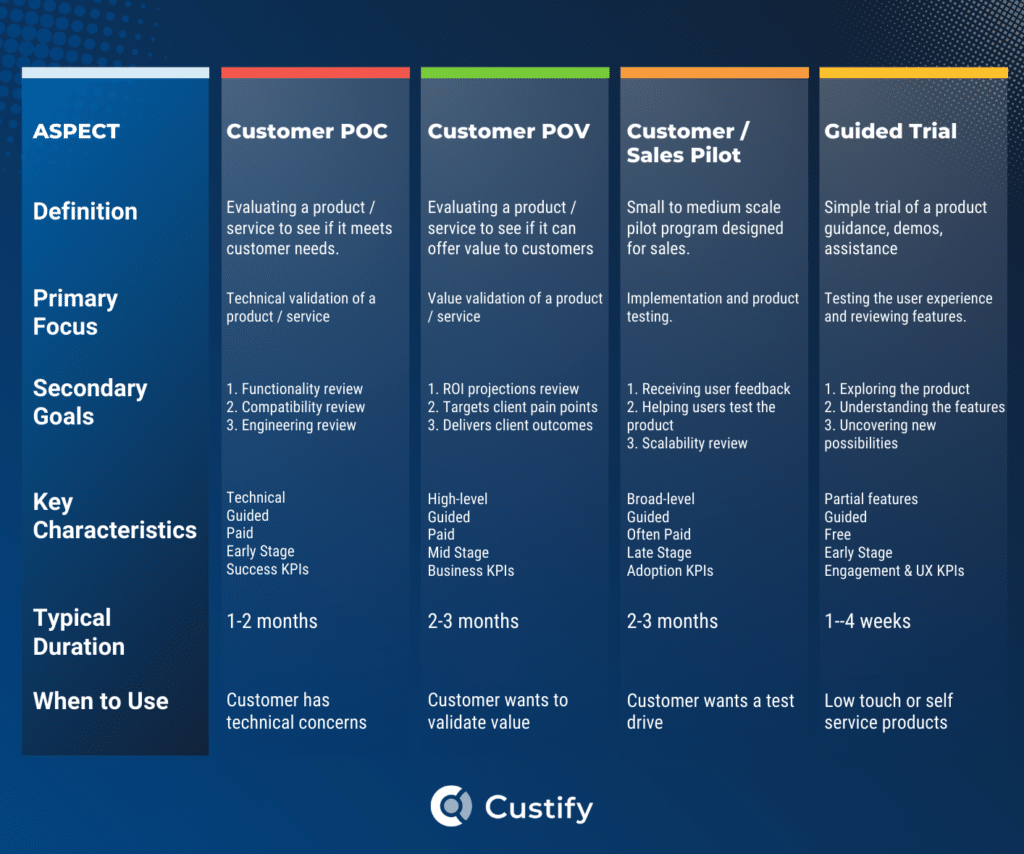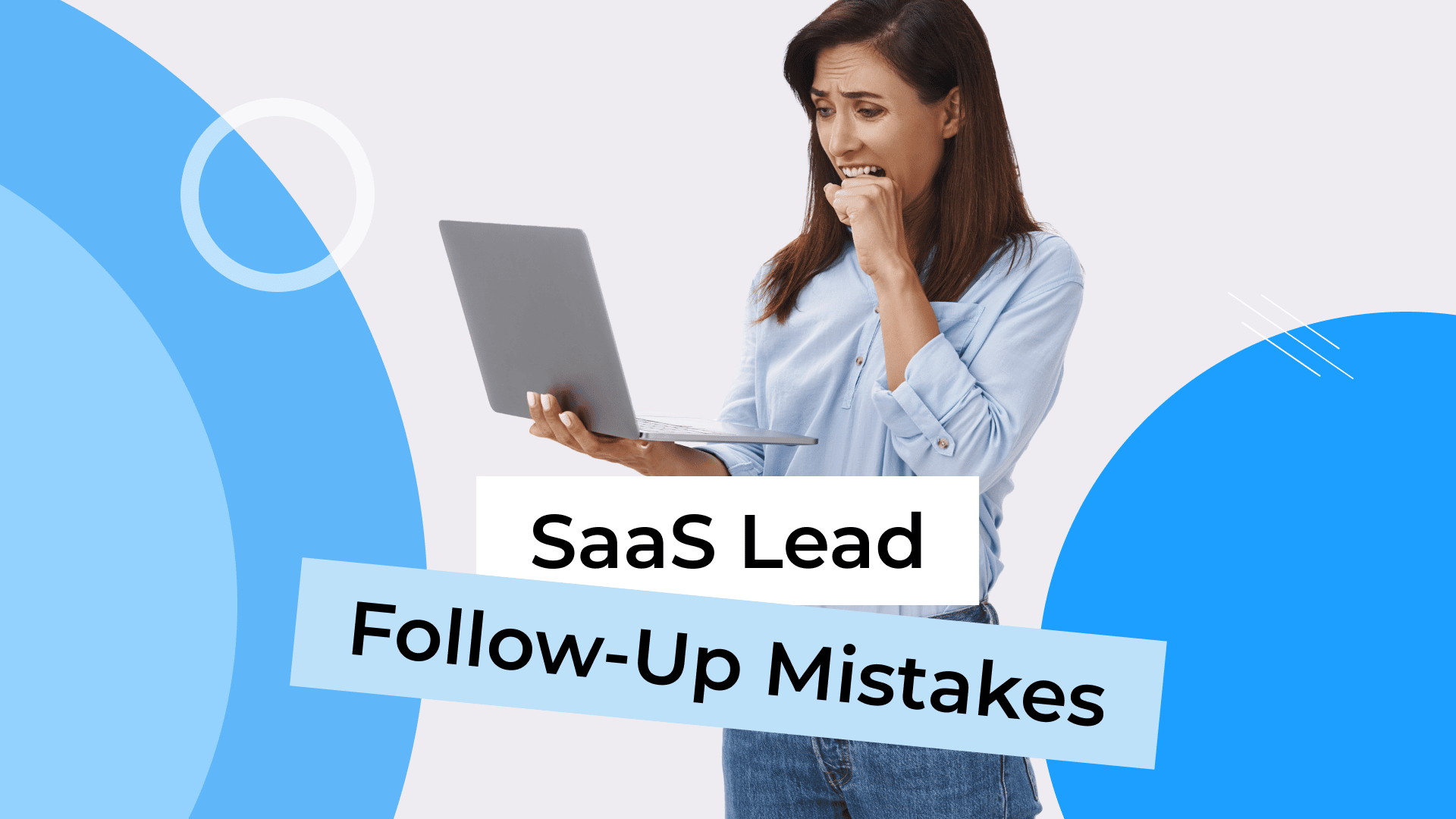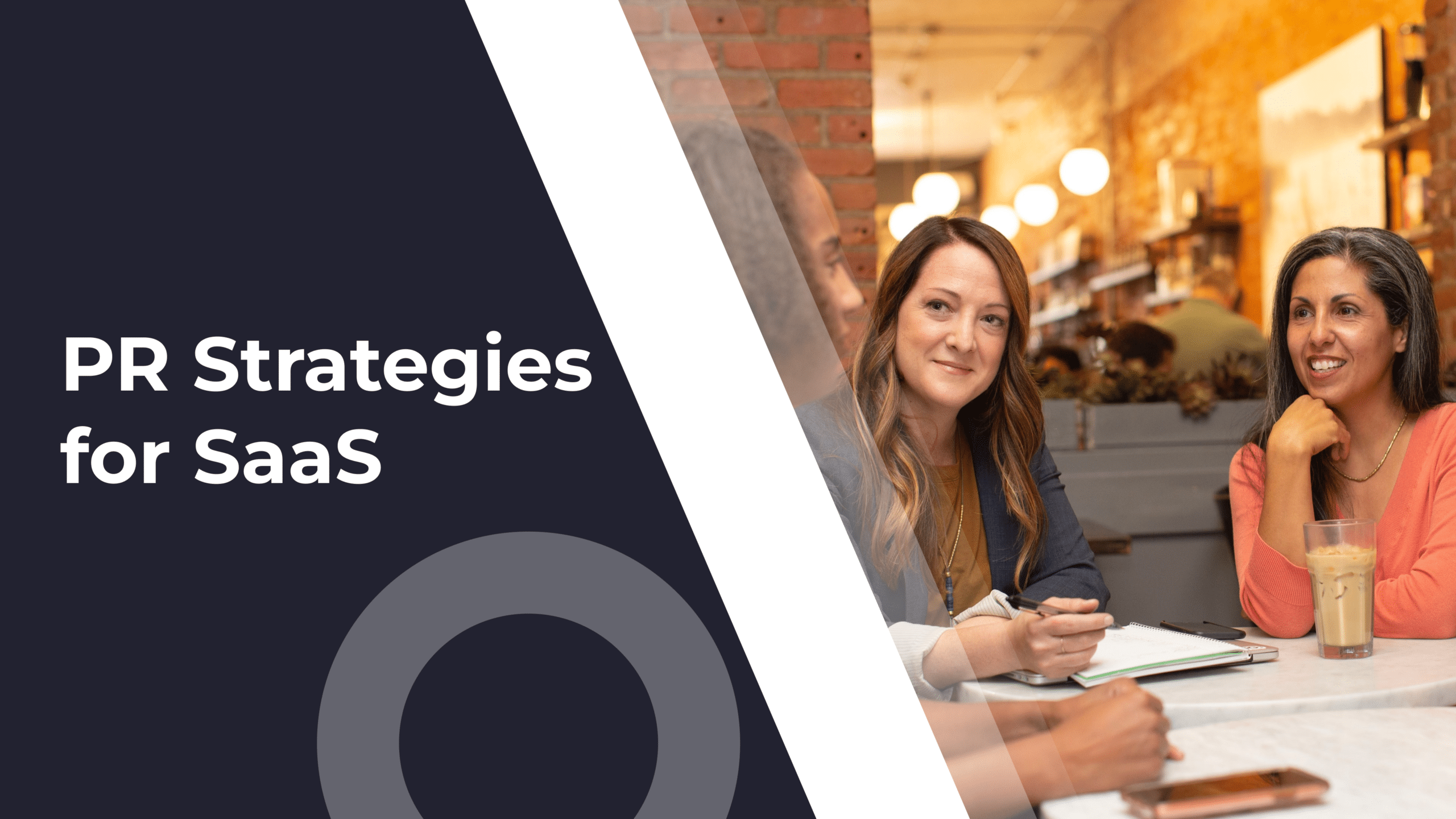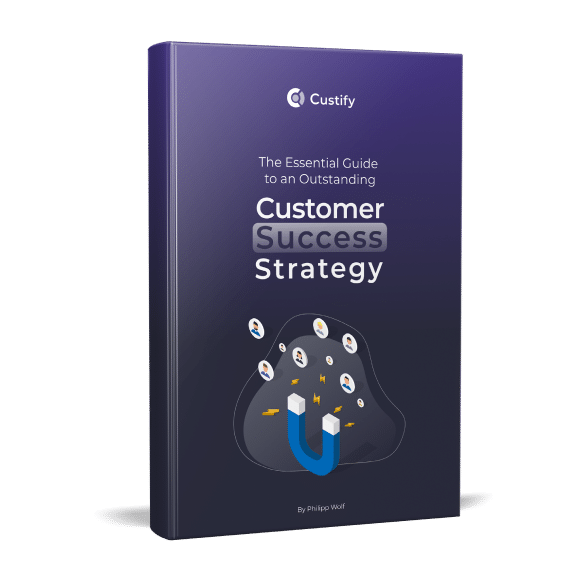When a customer is on the fence about a purchasing decision, particularly when it comes to high-touch SaaS products, a customer POC, or proof-of-concept, is necessary to get them over the line.
I’ve personally overseen a few POCs over the years as Head of CS, so today I’ll show you some hard lessons we had to learn along the way so you can make the most of your POCs.
We’ll look at what a customer POC is and what it could be, if done right, and how you can get there. Along the way I’ll show you some examples and some mistakes to avoid. Let’s begin!
What Is a Customer POC (Proof-of-Concept)?
A customer POC (proof of concept) is the process by which a customer evaluates a product or service to determine its feasibility, practicality, and whether it meets their expectations. For many, it’s an essential part of the sales cycle and decision-making process for new customers.
It can also be called a sales proof of concept, proof of value, customer / sales pilot, or a guided trial. However, this is not exactly correct, as most of these terms have slightly distinct definitions (which I’ll touch on a bit later).
Two key areas that customers typically evaluate are whether the product or service can help them meet their goals, and how usable it is in actuality. Most customers will want to know if they can understand the POC demo quickly and easily and how much effort it takes to implement the solution (and how much assistance they receive during the process).
It’s all part of the classic value realization framework, whereby customers test the value of the product or service against their expectations. Specifically, a Customer POC corresponds to the value realization and validation stages – where customers first see the value and attempt to replicate and validate it.
Do I Need a Customer POC?
This decision comes down to the type of product you have, your business model, your sales cycle, and your pricing model.
High touch, complex products and services will incur more scrutiny from potential customers before they decide on a long term business relationship and contract. The same can be said for more technical products, or those with a lengthy implementation cycle.
The Benefits of a Customer POC
- Allows customers to set up the essentials (tracking, etc)
- Lets customers test user satisfaction with the product or service
- Helps customers see the potential to grow (value realization / a-ha moment)
- Gives customers a period of enhanced support and assistance
- Preemptively prevents churn and increases customer retention
- Establishes a baseline of trust between the two parties and drives loyalty
Proof of Concept vs Proof of Value vs Pilot vs Trial
Customer POC is often used as an umbrella term to mean anything from a simple product trial to a full-blown, custom-developed sales pilot that lets the customer basically test their use case in production.
So what are the differences? How do we know which is which in our everyday business meetings? The CEO might be talking about a customer POC when they’re actually referring to a guided trial. Let’s look at the differences:

What Are the Steps of a Customer POC?
1. Planning
Any successful customer POC implementation starts with adequate planning and strategy. This typically includes discovery calls, onboarding calls, and extensive research by the provider (led by the key account manager or lead CSM for that account).
Your goals during this stage should be to:
- Get a clear response from POC clients regarding their goals.
- Understand their desired outcomes both for the POC and the overall product (even if slightly unclear – an experienced account lead will often understand what the customer wants better than the customers themselves).
- Outline the POC process, the steps required for that customer to be successful, the workflow needed to help them, and most of all, how to convert that customer to a full subscription.
- Determine the work customers need to do on their end, what the steps are, what type of collaterals to send them, and how often to check in to ensure implementation and value addition without becoming a nuisance.
2. Execution
Once the customer starts testing your solutions, the lead CSM must make sure they have everything at their disposal to succeed. This is a critical stage in the POC as it can be the difference between signing a full contract and customer churn.
Your role here is to:
- Assist the POC customer with materials, guides, advice, implementation support, and be there when they reach out for help.
- Ask the customer for feedback and be as specific as possible. Show customers you care about your own product and they will start to care as well.
- Ensure they’re taking full advantage of the value your product / services provide – use your customer success software to check their health scores. Ask yourself:
- are they using all the features?
- are they using the features correctly?
- could they be integrating more tools?
- are they working with good data?
- are there any friction points where they get stuck?
3. Evaluation
Next it’s time to take stock of where your customers are in their journey.
Now’s the time for a more in-depth analysis of your customers’ health scores to determine if they reached their objectives, and decide where to go from here. The next logical step is to attempt to convert the customer. However, sometimes, they may want a second POC – which is not ideal, but can be preferable to losing them entirely (or worse, them going to a competitor).
This is also the point where you see whether they are a good fit for your business or not. I’m serious – I’ve seen POC customers that ended up churning because of mismatched expectations, their inability to do the work required of them (even basic setup), and an overall lack of professionalism.
If I’m honest, it’s unfortunate that this is common in business. You could be the most diligent CSM in the world with the best product ever and some folks will still throw money on your POC, never use it, and eventually churn. It happens. It’s up to you to determine when and if you should fire your POC customer before they start becoming a drain on your company resources.
4. Full Implementation
Some simply call this “implementation” – but that’s misleading. You’ve already worked to implement the product for this customer during the initial stages of the POC. Conversely, moving to full implementation means:
- Providing training to ensure full adoption of the product / service within the customer’s organization.
- Working with your customer success engineering team to ensure any custom implementation requirements are set.
- Ensuring customers have every integration they require all set up and transmitting data to your product.
- Providing support along the way to full product adoption.
- Overall ensuring a smooth transition and the same level of customer support you’ve offered during the POC.
5. Optimization
Many think the POC ends once the customer’s signed the contract. Wrong. This is the time for you to review your processes, see what worked and what didn’t work during the POC, and generally try to improve whatever you can so the next customer can reach their goals faster, easier, and more reliably.
What Does a Successful POC Look Like?
Essential Elements to POC Success
Regardless of how advanced your POC process is, these are the elements that should always be there in some form. You will notice that most of these naturally fall under the “planning” stage mentioned above, as 65% of onboarding managers note that onboarding success means more renewals and faster upsells.
1. Customer Discovery and Goal Alignment
The first step to customer discovery for a POC is to have a ready-made script for your first call. Then, once a customer asks your sales rep for a POC, you need a thorough sales handoff to help make that initial touchpoint as impactful as possible. Using the information in the handoff, narrow down the questions, add more, and remove anything you already know.
In our experience, this is often the first taste customers get of the value you provide – and it can be the deciding factor. If a customer’s asking for a POC, they’re likely pitting you against your competitors at that very moment. They may have even signed up for other POCs. Are you prepared to outshine them?
When leading a POC, remember customers often compare multiple products or even POCs at the same time. This can lead to big misunderstandings and confusion if they mix up their expectations. So always clarify that customers expect realistic things from your POC vs 5 other POCs from competitors.
– Andreea Cheregi, Senior Customer Success Manager, Custify
Your task as the CSM in charge at this stage is to eliminate any possibility of a misunderstanding and to clarify the customer’s overall goals and their expectations of the POC.
2. Onboarding
The next essential step is the onboarding itself. SaaS onboarding in particular is a complex process that leads customers through your product and helps them understand the next steps. A good onboarding process will give customers a clear understanding of the value they should expect and the steps necessary to reach it.
We also like to assess engineering requirements during this stage and do a soft tech onboarding. Particularly for POC customers, it’s important to understand what’s required of them to implement your solution: how much effort is needed, whether there’s any engineering work involved, what kind of integrations they need so the provider can facilitate that.
Remember that during the POC, the time you have to bring those customers to the A-ha moment is limited. As such, anything you can do to shorten the onboarding and make it more goal-aligned will translate to a higher win rate when those customers actually decide whether to go for a full subscription or not.
3. Customer Research
Also during the planning stage, you and your team should take the time to learn about the customer. This doesn’t simply mean asking questions during your calls – it means active research, product demos, and even some engineering work to understand how your two solutions can synergize.
Many companies skip over this step and it shows, with a recent report showing consumers only see true personalized engagement 47% of the time. But with proper care and attention, you could be boosting your MRR as the same report shows 55% of consumers would spend more if their experience was personalized.
4. Implementation Guide
Moving on to the execution stage, one thing that’s super impactful (and that I also do with my team) is sending implementation guides to customers after we’re done with the onboarding calls.
We’ve noticed that one of the biggest roadblocks to adoption is customers getting lost in all the work they need to do for implementation. Other times, they simply forget to do the work on their end.
An implementation guide is a simple document that outlines the steps customers need to take, ordered from most important to least important, with complete explanations regarding dependencies (this step is required by the other step, and so on).
Sending the guide isn’t simply a way to help them, it’s also a reminder they need to do these things in order to reach their POC goals. Compare it to a basic Slack reminder – maybe you had the call two weeks ago, who can remember all the steps? This way, you’re giving them a detailed, strategic checklist and they can get to work right away.
5. Work Session(s)
Last, but definitely not least, you will discover that customers often need more help than you planned for, particularly if you want to get them over the finish line before the POC expires.
To that end, I recommend setting work sessions with the customer for 2-3 hour slots (or whatever duration makes sense for your product). That time should be solely dedicated to setting up everything together, so that customers see how you do it, understand how to do it themselves, and get value from the overall experience.
Customer POC Lessons We’ve Learned
- Don’t offer less than you do for your regular customers. Remember – that’s no POC, that’s basically a trial. Just because a customer opts for a POC doesn’t mean they shouldn’t benefit from the same product and service quality as your other customers.
- Always aim to offer value, no matter what form that value takes. Sometimes, no matter what you do, the optimal value delivery depend on the customer doing the work, and that means it’s mostly in their hands. You can, however, step in to offer additional value whether that be through regular check-ins, the work sessions we talked about, or that implementation guide we also mentioned.
- While they’re evaluating the product, you’re evaluating them. Remember point three from the customer POC stages above. Business relationships go two ways – and you don’t want customers that will make your processes sluggish, act stingy, and ultimately churn.
- Come up with questions for your customers during the POC lifetime. The entire POC process is a constant learning experience as you move from customer to customer, from POC to POC. Write down questions for every customer and see what you can do to improve their experience, and the overall experience of anyone going for a POC.
- Try to push POC customers to do the work required of them. Lastly, you’ll be tempted to give customers time to implement your solution. But remember you don’t have that much time yourself before they churn due to inactivity. So – prepare that guide, create a schedule for reminders, add meetings to their calendar. Think of it like this: they’re paying you to get some value, you’re there to ensure they receive it.
Hear from Our Successful POC Customers
Most of the methodology in this article is similar to how we operate at Custify. We take pride in caring for our customers during their POC and getting them to that value realization stage so coveted by other SaaS. And they all told us the same thing – our concierge onboarding is miles above the competition and, because we also offer it for POCs, it’s a big hit.
Following are two of our customers talking about how their POC went. Maybe it will give you a few ideas to optimize your POCs.
The reason I was able to trust Custify was that I got a chance to do a POC with them. Obviously, it gave me a few months where we could test it out and see if our team is able to adapt well to it and all our requirements are met. Once everything was done, we opted for Custify as our official CS platform.
When we first started looking at Custify, the first thing we wanted to do was track all the metrics that we had for our customers. We wanted a single place where everything could be added, plus on top of that the notes feature. We were already aware that people could add notes to it.
So we wanted one place where CSMs could see the health of a customer, the usage of a customer, as well as add notes to it and add health score. So this was the thing that really helped us during the POC to make the decision.
We also wanted to measure the satisfaction of our CSMs on this. So I even ran a survey of all our CSMs to see how Custify is helping them. Once I found that they were all satisfied with the platform and we had a lot of potential to grow with this, I decided to go for a full contract with Custify.
– Rahul Katyal, Director of Customer Success, Recruit CRM
I put all the challenges on slides and I understood I was looking for the platform that would help me resolve those challenges. And mostly, the POC was a requirement from my management, because we needed to understand: Okay, if we go there, before we actually scale for the full team, before I start to invite some other users, some other departments:
1. Is it really what we are looking for?
2. Would it really be very useful for the team as it is in the concept?So we started with the POC, and in the end of the POC we went back to the same presentation to understand:
- where we were at that time
- if the initial goals were successful or not
- how much time it required
- would it involve other people from other departments?
- would it involve a lot of integration, communication from the tech team?
So I presented everything that I was able to achieve, of course, with the help of the CSM who was absolutely helpful to set up the project. This is why, after the POC ended, we were able to proceed with one year and renew now for another year.
– Marina Akimova, Head of Customer Success, BeMyEye
Customer POC Mistakes and What to Do Instead
1. Not offering a true POC
It’s unfortunate that many companies, particularly SaaS ones, claim to offer a POC but in fact have something more akin to a guided trial.
What To Do
Offer a true POC. It should be a paid, smaller-scale implementation of your product, and must be able to naturally lead into a full subscription with minimal hassle. The customer must be able to complete their onboarding, integrations, and implementation processes. They must then be able to achieve their POC goals and see the clear path towards their broader goals past the POC end date.
2. Misunderstanding customers’ desired outcomes
One of the foundational, relationship-defining moments of a customer POC is the discovery phase – where the lead CSM attempts to understand the customer and their goals.
What to Do
Take extra care to define, plan for, and execute the discovery and onboarding processes when dealing with POC customers. Make sure to write down and ask the right questions.
3. Lacking alignment on customer value expectations
Not all customers plainly state what they want. They may expect something more from you than simply reaching their goals – such as expert support, other forms of value, and assistance along their journey.
What to Do
Besides syncing with the customer and asking them, do your own research, compare the POC client to lookalike accounts and see whether their goals match.
4. Going for a “set it and forget it” approach
Possibly the biggest mistake one can make when putting together a Customer POC is to forget about it once implementation is done. Remember value realization and validation are key for customers at this stage.
What to Do
Regularly check in, offer assistance, monitor health scores, and send guides to help POC customers on their journey. Be on the lookout for roadblocks and friction points that may lead to churn. And always use the insights gained during POCs to improve the product or service offering.
How Customer Success Software Can Calibrate Your Customer POC
Throughout your customer POC, one thing will remain constant – your need for accurate, actionable, and easily-accessible customer data. As the lead CSM of the account, you are responsible for checking how the POC is going, and should be ready to act when your signals point one way or the other.
For that, you could use an ally – a customer success platform that can:
- gather up all those KPIs
- pin them to your dashboard
- act automatically by notifying you, sending product guides to the customer, or simply emailing you when the POC’s about to end
All of these and more are covered by Custify, so why not try our POC? Take it from Rahul and Marina above – it may just be the turning point you needed.




